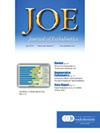Sodium Hypochlorite Accidents: A Retrospective Case-series Analysis of CBCT Imaging and Clinician Surveys
IF 3.6
2区 医学
Q1 DENTISTRY, ORAL SURGERY & MEDICINE
引用次数: 0
Abstract
This case series study aims to investigate retrospectively the causes underlying sodium hypochlorite (NaOCl) accidents in endodontic practices through analysis of cone beam computed tomography (CBCT) imaging and comprehensive clinician surveys. Twenty-four dental practitioners who encountered a NaOCl accident during the treatment of a permanent tooth in adult patients provided deidentified patient data, facial photographs, and a limited field of view CBCT of the involved tooth. Providers also had to report patient's immediate presence of pain and swelling after root canal irrigation to include the dataset into the study. Modified surveys were administered to collect information on other demographic factors including age, sex, tooth involved, apical diagnosis, presence of ecchymosis, pain severity, among others. The CBCT volume was used to identify the presence of fenestration, root perforation, and apical pathosis. CBCT data were evaluated by 4 examiners. Among the 26 NaOCl accidents investigated, a higher incidence was observed in females (65.30%) and maxillary teeth (92.30%). All cases presented immediate swelling and edema; intracanal bleeding and hematoma were observed in 80.70 and 84.60% of the cases respectively. CBCT interpretation revealed that bone fenestrations were evident in all cases studied (100%), iatrogenic perforations were detected in 19.23% of the cases, and apical pathosis was noted in 30.70% of the cases. This case series study highlights that a direct communication between the root apex and surrounding soft tissues is highly prevalent in NaOCl accidents. Early identification of bone fenestrations or perforations identified in maxillary teeth of female patients can play a pivotal role in preventing NaOCl extrusion accidents during endodontic treatment.
次氯酸钠事故:CBCT影像和临床调查回顾性病例系列分析。
目的:本病例系列研究旨在通过锥形束计算机断层扫描(CBCT)成像分析和综合临床调查,回顾性探讨根管治疗中次氯酸钠(NaOCl)事故的原因。方法:24名牙科医生在治疗成年患者的恒牙时遇到了NaOCl事故,他们提供了未识别的患者数据、面部照片和受损伤牙齿的有限视野CBCT。提供者还必须报告患者在根管冲洗后立即出现疼痛和肿胀的情况,以将数据集纳入研究。进行修改后的调查,以收集其他人口统计因素的信息,包括年龄、性别、涉及的牙齿、根尖诊断、瘀斑的存在、疼痛严重程度等。CBCT容积用于确定开窗、根穿孔和根尖病变的存在。CBCT数据由四名检查者评估。结果:在所调查的26例NaOCl事故中,女性发生率最高(65%),上颌牙发生率最高(92%)。所有病例均出现立即肿胀和水肿;肛内出血和血肿发生率分别为80.7%和84.6%。CBCT解释显示,所有病例(100%)均有明显的骨开孔,19%的病例存在医源性穿孔,30.7%的病例存在根尖病变。结论:本病例系列研究强调,在NaOCl事故中,根尖与周围软组织之间的直接交流非常普遍。早期发现女性患者上颌牙存在骨开孔或穿孔,对于预防牙髓治疗中发生的NaOCl挤压事故具有关键作用。
本文章由计算机程序翻译,如有差异,请以英文原文为准。
求助全文
约1分钟内获得全文
求助全文
来源期刊

Journal of endodontics
医学-牙科与口腔外科
CiteScore
8.80
自引率
9.50%
发文量
224
审稿时长
42 days
期刊介绍:
The Journal of Endodontics, the official journal of the American Association of Endodontists, publishes scientific articles, case reports and comparison studies evaluating materials and methods of pulp conservation and endodontic treatment. Endodontists and general dentists can learn about new concepts in root canal treatment and the latest advances in techniques and instrumentation in the one journal that helps them keep pace with rapid changes in this field.
 求助内容:
求助内容: 应助结果提醒方式:
应助结果提醒方式:


